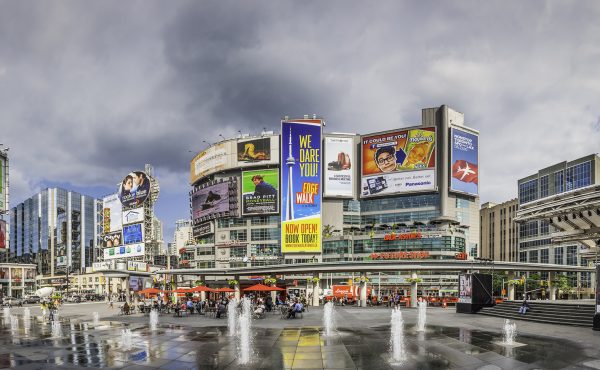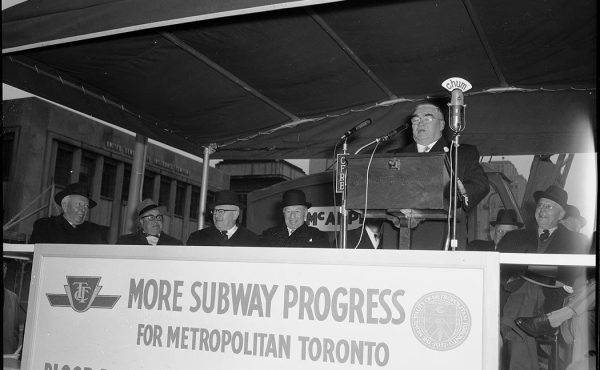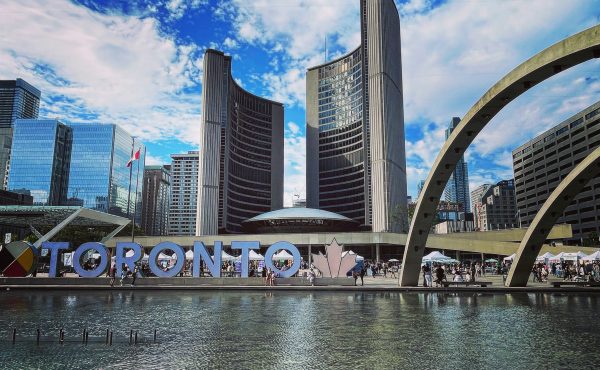Comparing the geographic representation of Miller’s and Ford’s Executive Committees. Pretend there’s an asterisk in ward 4 (explained in a bullet point below).
On a recent edition of Metro Morning, Councillor Adam Vaughan argued that — for strictly practical reasons — it is foolhardy for Mayor Ford to not have placed any representatives from the former City of Toronto on major committees. “The reality is is that when you try to stage something like the G20 or when you have to run a streetcar line through a dense urban neighbourhood, as opposed to a differently built neighbourhood north of the 401…it’s a different experience,” the ward 20 (Trinity-Spadina) councillor explained. “And just as I wouldn’t expect to have the expertise to manage affairs in Giorgio Mammoliti’s part of the city, or Denzil Minnan-Wong’s part of the city, I think they need my advice — and not just my advice but the advice that I bring to the table on behalf of the businesses and the residents I represent — when making critical decisions about infrastructure investments, about how to stage a parade, about how to effectively govern the city.”
Running counter to this is the myth that Mayor Ford’s committees are merely an inversion of Mayor Miller’s and that the people speaking out about the exclusion of the downtown are simply sore losers. What’s getting lost in the discussion is that while Miller’s committees indeed drew most heavily from the core, he would usually make an effort to include representation from each of the city’s major districts.
I’ve made up some graphics to illustrate the contrast in Miller’s and Ford’s approaches to populating their Executive Committees, Budget Committees, and Toronto Transit Commissions. (Vaughan also cites Ford’s appointees to the Police Services Board and Toronto Community Housing Board as similarly problematic, but because neither is exclusively comprised of city councillors, illustrating their memberships in map form is not quite as straightforward.)
In all cases, I’ve compared the new entities to the way they looked following the shuffle mid-way through Miller’s second term. And as for neatly slotting each ward into a particular district, I’ve gone with the breakdown used for the community councils.
**
Miller’s Executive Committee
Toronto and East York District: Joe Pantalone (19), Pam McConnell (28), Paula Fletcher (30), Janet Davis (31), Kyle Rae (27), Joe Mihevc (21)
North York District: Shelley Carroll (33), Howard Moscoe (15)
Etobicoke York District: Giorgio Mammoliti (7), Gloria Lindsay Luby (4)
Scarborough District: Norm Kelly (40), Glenn De Baeremaeker (38)
*
Ford’s Executive Committee
Toronto and East York District: none
North York District: David Shiner (24), Jaye Robinson (25), Denzil Minnan-Wong (34)
Etobicoke York District: Doug Holyday (3), Peter Milczyn (5), Cesar Palacio (17), Giorgio Mammoliti (7)
Scarborough District: Mike Del Grande (39), Norm Kelly (40), Michael Thompson (37), Michelle Berardinetti (35), Paul Ainslie (43)
**
Notes:
• The mayor is the chair of the Executive Committee, but of course does not himself represent a particular ward. That said, before being elected to the top office, Miller represented ward 13 (Parkdale–High Park) and Ford represented ward 2 (Etobicoke North).
• Brian Ashton (ward 36, Scarborough Southwest) was a member of Miller’s Executive when it was first established in December 2006. But Miller requested Ashton’s resignation in late July, 2007, shortly after his last-minute change of heart on the Vehicle Registration and Land Transfer Taxes. The mayor then approached Adrian Heaps — the other Scarborough Southwest councillor — to fill the spot, but Heaps declined. (According to a Star article at the time, one reason Miller “was keen on Heaps [was] because the councillor represents Scarborough, an area the mayor is eager to include when appointing councillors to key committees.”) Miller then instead went with Janet Davis, who represents the adjacent ward 31, in the heart of East York.
• Three days after Mayor Miller’s September 25, 2009, announcement that he would not seek a third term, Councillor Gloria Lindsay Luby (ward 4, Etobicoke Centre) abruptly quit his Executive, as she evidently deduced there was nothing left to gain (and possibly much to lose) by continuing to align herself with him. Councillor Peter Milczyn, no fan of Miller, offered this blunt quote to the Globe: “The one thing you can count on with Gloria is that she’s nakedly ambitious and self-serving.” She was not replaced.
***
Toronto and East York District: Gord Perks (14), Joe Mihevc (21), Kyle Rae (27)
North York District: Shelley Carroll (33) (chair), Maria Augimeri (9)
Etobicoke York District: none
Scarborough District: Adrian Heaps (35), Paul Ainslie (43)
*
Ford’s Budget Committee
Toronto and East York District: none
North York District: John Parker (26)
Etobicoke York District: Doug Ford (2), Peter Milczyn (5), Frank Di Giorgio (12)
Scarborough District: Mike Del Grande (39) (chair), Chin Lee (41), Michelle Berardinetti (35)
**
• The membership of Miller’s Budget Committee remained stable throughout his second term.
***
Toronto and East York District: Adam Giambrone (18) (chair), Joe Mihevc (21), Sandra Bussin (32)
North York District: Anthony Perruzza (8), Maria Augimeri (9)
Etobicoke York District: Bill Saundercook (13), Suzan Hall (1), Peter Milczyn (5)
Scarborough District: Ron Moeser (44)
*
Ford’s TTC
Toronto and East York District: none
North York District: Karen Stintz (16) (chair), John Parker (26), Denzil Minnan-Wong (34), Maria Augimeri (9)
Etobicoke York District: Cesar Palacio (17), Frank Di Giorgio (12), Vincent Crisanti (1), Peter Milczyn (1)
Scarborough District: Norm Kelly (40)
**
• At the half-way point in the last Council term, Maria Augimeri (ward 9, York Centre) and Ron Moeser (ward 44, Scarborough East) replaced Glenn De Baeremaeker (ward 38, Scarborough Centre) and Michael Thompson (ward 37, Scarborough Centre). De Baeremaeker’s exit was voluntary; Thompson’s was not.
***
“It’s not an ideological thing, or a cultural thing,” Vaughan told Metro Morning. “It’s just that the lived experience of people who live in particular parts of the city are what comprise our civic intelligence and our institutional memory. And if they’ve chosen not to have that around the table…it’s gonna be a difficult time to work together, not on ideological issues…but just on how to manage the physical realities of Toronto. You need everyone’s input to make good, smart decisions.”







18 comments
Not being a Torontonian (or even lived in Ontario), I can only look at the maps and the people who claim that Miller shut out the suburbs do have a point: The inner core of Toronto controls the lion’s share of the old Miller exec. However, that doesn’t excuse Ford’s behaviour, which is worse.
Notable: The new TTC has a large number of councillors along the Eglinton LRT route… not totally sure how to read that.
Corey: If by the lion’s share you mean 4, then, yeah.
Corey, unless you are using a definition of “shut out” that no one else uses (or you don’t know how to look at a map), then of course you are wrong. There are 5 from the suburbs and 2 from the inner suburbs on Miller’s executive.
Jonathan renders an important service here that further destroys the myth perpetuated by the right wing. There is this notion that Ford is just a pendulum swing and that the suburbs are finally getting theirs and giving back to the inner city what it had coming. Look no further than Don Cherry’s spout off which was heartily embraced as a needed correction.
The difference, however, is that the right may well have been outvoted during Miller’s reign, it was never disrespected. I challenge anyone to find an example of an officially sanctioned “fuck you” a la Cherry from anyone during the Miller regime. You won’t find it because Miller, above almost all else promoted inclusiveness and respect during his tenure.
Thank you so much for these maps and this article. It brings some reality to all the crap i absorb from radio/t.v./mainstream news.
Is it possible to advocate for inclusion of some of these Spacing articles in mainstream media somehow???
Good post. It would also be interesting to see similar information for Miller’s committees in the 2003-2006 term and even for Lastman. One opinion that I’ve heard is that in his first term, Miller did a good job of balancing power and opinions but then went too far towards the downtown and/or left after 2006, both in terms of the people in power and the policies they adopted. David Socknaki, who was his first budget chief alluded to this on Metro Morning shortly after Ford’s election.
Lastman, meanwhile, is viewed as someone who put the more conservative and/or suburban councilors in leading roles, but generally stayed in the centre and still gave the Jack Laytons and Joe Panatalones of the world important jobs to do. I’m curious how the numbers reflect this view.
Another potentially useful tool for understanding the situation might be a map showing population by ward, and what percentage of Toronto’s population is, and is not, represented on the new committees and councils. You would think that “no taxation without representation” would be a principle adhered to by a business-oriented regime.
If Toronto can’t or won’t deamalgamate, shouldn’t the committees on council be represented from at least one member from each of the former cities (and burough!) of the megacity?
CJM – my thoughts exactly. Hopefully the progressive candidate in the 2014 election will include this in their platform. At a minimum, every committee should have at least one member representing each of the four districts. However, I wouldn’t go as far as including representation from all of the former cities and borough; I think we’d be OK with Toronto-East York, Etobicoke-York, North York and Scarborough.
Well, the slightly good news is that even without any representation, downtown is kind of like the “house” in a gambling analogy: it always wins.
What I mean by that is that the way the global economy has been heading for the past 30 years, the specialized service and creative industries that form the basis of our post-industrial economy tend to settle downtown or in outer suburbs. Meanwhile the relatively dour inner suburbs that are still clinging to some outdated notion of blue collar manufacturing romanticism will continue to decline, whether they vote for someone like Rob Ford, or not.
Mayor Ford could attempt to strangle downtown Toronto as much as he wants, and downtown would still continue to be the place that attracts the most investment in the 416. It would be where the majority of condos are built and where most of the job growth in the city would take place. Notice how much areas like Liberty Village and the eastern end of King Street have exploded despite basically zero investment in public services, while developers are not exactly lining up to build condos along the new Spadina line.
I would also point out that downtown’s densities and relatively heterogeneous demographic makeup mean that a lot of services can be supported with very little public input. Not that I advocate this, but if they cut service on the 94 Wellesley bus or closed the Alexandra Park library, I’m sure people would adjust (albeit grudgingly) to walking further north to catch the subway or using the relatively nearby Lillian Smith or College/Shaw branches. On the other hand, if you axe the Burnhampthorpe bus, you’re looking at at least 1 km extra walk to the nearest bus stop; if you closed the Guildwood branch of the TPL, the nearest library would be 4 km away.
PS: By “zero investment in public services” in the case of Liberty Village et al, I really should have specified zero investment in public transit, or at least a negligible amount compared to the amount of private investment in the area.
Jonathan,
Yes, excluding politicians who represent the Toronto East York area from important posts in his administration shows the Mayor is hyper-partisan willing to worsen divisions within the City. I don’t much care. We already knew those things about him.
The much more important exclusion will come from his tax cut program. Taxes are the way we pay for common services:public health, public libraries, public transit and more. As those common services shrink people with less personal wealth will see a decline in their quality of life and their access to opportunity.
That’s the real exclusion Mayor Ford’s policies create. That’s what we need to map and get angry about.
Gord
I guess I should rephrase by saying that Miller’s exec was more heavily weighted towards more central wards and Ford’s is the opposite. As a non-Torontonian, I don’t know where the old citie’ borders ran and cannot see the lines on the map that may signify massive cultural changes in small geographic areas, but I am well aware they likely exist. I am heavily involved in politics in the wealthy, snobby Victoria suburb of Oak Bay, whose border is largely invisible on the map.
As for forcing some sort of artificial representation based on old boundaries, wouldn’t it be smarter to attempt to unify by not reinforcing the old divisions?
Leonard, for the most part I agree with your comment. Only I recall a period of time that there was an absolute decline in development and employment in the core while the outer suburbs were growing strongly. Your comments about positioning in a post industrial economy are all with merit. Only, I believe that eventually we will be a re-industrialized society. Mercantilism will run its course and Canada (the US and the West in general ) will need to face up to the realities that this is inevitable because unemployment levels would be intolerable otherwise.
As to the topic at hand, if ideology was geography the maps would have looked near identical. Or even reversed.
Miller’s exec was more heavily weighted towards more central wards and Ford’s is the opposite.
No – this attempt at equivalence between what Miller supposedly did to the suburbs and what Ford is doing to downtown is false.
Miller’s exec may have had slightly favoured the downtown, but he included representatives from all over the city – Etobicoke, North York, Scarborough. Ford excludes entirely the downtown, and is thus not “the opposite”.
Ward 17 should be in the Toronto Council. A greater percentage of it was in the old city of Toronto than wards 29, 31 and possibly 21. If it replaced one of those wards, I wonder whether that would reduce the sting. Somehow I doubt it.
Miller’s Exec may have been more geographically diverse, but to be fair, he may have had more allies to work with.
As we saw with the Ashton case, the rules seem to be the same for both administrations: If you want to be on exec, you need to support the Mayor’s key initiatives. Isn’t that “partisanship”?
Miller was able to find allies in North York, Scarborough and Etobicoke who (for opportunistic reasons or otherwise) agreed to support the mayor’s platform. But there are likely no Councillors in Toronto East York district who would have signed on. (Maybe Anna would have – but is it really a bad thing that she didn’t?. I would say not).
So I would argue it has more to do with circumstance, rather than Ford being exclusive or partisan. The rules, and approach to politics, seem unchanged to me.